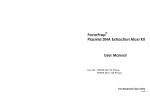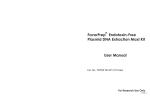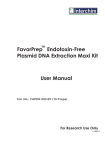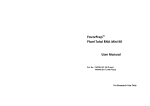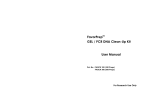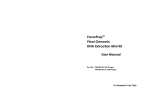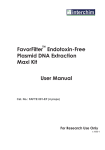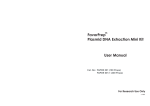Download User Manual FavorPrep Plasmid DNA Extraction Midi
Transcript
TM FavorPrep Plasmid DNA Extraction Midi Kit User Manual Cat. No.: FAPDE 002 (25 Preps) FAPDE 002-1 (50 Preps) For Research Use Only v.1005-1 Introduction Ordering Information FavorPrepTM Plasmid DNA Extraction Midi Kit is designed for efficient extraction of high quality plasmid DNA from bacterial culture. This kit provide the alkaline lysis reagents and the columns packed with anion-exchanger resin. After the cells lysis, the plasmid DNA is bound to the resin insided the column by a gravity-flow procedure, and the contaminants can be remove with wash buffer. After using this convenient kit, the purified plasmid DNA is suitable for downstream application such as transfection, in vitro transcription and translation, and all enzymatic modification. Specification: Sample Size: up to 60 ml of bacteria for high-copy number plasmid up to 120 ml of bacteria for low-copy number plasmid Binding Capacity: 650 µg / column Kit Contents FAPDE 002 (25 preps) PEQ Buffer PM1 Buffer PM2 Buffer PM3 Buffer PW Buffer PEL Buffer RNase A (50 mg/ ml) PM Midi Column 135 ml 215 ml 215 ml 215 ml 165 ml x 2 215 ml 430 µl 25 pcs 1 FAPDE 002-1 (50 preps) 135 ml x 2 215 ml x 2 215 ml x 2 215 ml x 2 165 ml x 4 215 ml x 2 430 µl x 2 50 pcs 6 Troubleshooting: Important Notes: 1. Brief spin the RNase A tube and adding the RNase A to PM1 Buffer. Store PM1 Buffer at 4 °C after adding RNase A. Low yield Bacterial cells were not lysed completely 2. If precipitates have formed in PM2 Buffer, warm the buffer in 37°C waterbath to dissolve preciptates. •Too many bacterial cells were used. •After PM3 Buffer addition, break up the precipitate by inverting. •DNA failed to precipitate or DNA pellet was lost after precipitation. •DNA pellet was insufficiiently redissolved. Additional Requirements: 1. 50 ml centrifuge tube Purified DNA dose not perform well in downstream application RNA contamination •Make sure that that RNase A was has been added in PM1 Buffer when first using. If RNase A added PM1 Buffer is overdue, add additional RNase A. •Too many bacterial cells were used, reduce the sample volume. Genomic DNA contamination 2. Isopropanol 3. 70% ethanol Brief Procedure: Culture bacteria cells •Do not use overgrown bacterial culture. •During PM2 and PM3 Buffer addition, mix gently to prevent genomic DNA shearing. •Lysis time was too long (over 5 minutes). Harvest bacteria cells Resuspend (PM1) Lyse (PM2) Neutralize (PM3) centrifuge Equilibrate Plasmid Midi Columnls by gravity flow (PEQ Buffer) DNA Binding Washing( PW Buffer) DNA Elution( PEL Buffer) Too much salt residual in DNA pellet •Wash the DNA pellet twice with 70% ethanol. Precipitate DNA Washing Dissolve DNA centrifuge Pure plasmid DNA 5 2 General Protocol: 1. Place a PM Midi Column into a 50 ml centrifuge tube. Add 5 ml of PEQ Buffer to equilibrate the PM Midi column and allow the column to empty by gravity flow. Discard the filtrate. 2. Harvest the bacterial culture by centrifugation at 6,000 x g for 15 minutes. 3. Add 8 ml of PM1 Buffer (RNase A added) to resuspend the cell pellet by vortexing or pipetting. 4. Add 8 ml of PM2 Buffer and mix gently by inverting the tube 15 times. Do not vortex to avoid shearing genomic DNA. 5. Incubate for 3 minutes at room temperature until lysate clears. 6. Add 8 ml of PM3 Buffer and mix immediately by inverting the tube 10 times (Do not vortex !). 7. Centrifuge at 15,000 x g for 20 minutes at 4°C. • Centrifuge speed should not be less than 15,000 x g. 8. Transfer the supernatant to the equilibrated PM Midi Column and allow the column to empty by gravity flow. Discard the filtrate. 9. Add 12 ml of PW Buffer to wash the PM Midi column and allow the column to empty by gravity flow. Discard the filtrate. 10. Place the PM Midi column into a clean 50 ml centrifuge tube (not provided) and add 8 ml of PEL Buffer to elute DNA by gravity flow. 11. Precipitate DNA by adding 6 ml of isopropanol to the eluted DNA from previous step. Mix well by inverting the tube 10 times. 12. Centrifuge at 20,000 x g for 30 minutes at 4 °C. • Centrifuge speed should not be less than 20,000 x g. 13. Carefully remove the supernatant and wash the DNA pellet with 5 ml of room temperature 70% ethanol. 14. Centrifuge at 20,000 x g for 10 minutes at 4 °C. • Centrifuge speed should not be less than 20,000 x g. 15. Carefully remove the supernatant. Then air-dry the DNA pellet until the tube is completely dry. (Or incubate the DNA pellet at 70 °C for 10 min.) 16. Dissolve the DNA pellet in 300 µl or a suitable volume of TE buffer or ddH2O. 3 4 General Protocol: 1. Place a PM Midi Column into a 50 ml centrifuge tube. Add 5 ml of PEQ Buffer to equilibrate the PM Midi column and allow the column to empty by gravity flow. Discard the filtrate. 2. Harvest the bacterial culture by centrifugation at 6,000 x g for 15 minutes. 3. Add 8 ml of PM1 Buffer (RNase A added) to resuspend the cell pellet by vortexing or pipetting. 4. Add 8 ml of PM2 Buffer and mix gently by inverting the tube 15 times. Do not vortex to avoid shearing genomic DNA. 5. Incubate for 3 minutes at room temperature until lysate clears. 6. Add 8 ml of PM3 Buffer and mix immediately by inverting the tube 10 times (Do not vortex !). 7. Centrifuge at 15,000 x g for 20 minutes at 4°C. • Centrifuge speed should not be less than 15,000 x g. 8. Transfer the supernatant to the equilibrated PM Midi Column and allow the column to empty by gravity flow. Discard the filtrate. 9. Add 12 ml of PW Buffer to wash the PM Midi column and allow the column to empty by gravity flow. Discard the filtrate. 10. Place the PM Midi column into a clean 50 ml centrifuge tube (not provided) and add 8 ml of PEL Buffer to elute DNA by gravity flow. 11. Precipitate DNA by adding 6 ml of isopropanol to the eluted DNA from previous step. Mix well by inverting the tube 10 times. 12. Centrifuge at 20,000 x g for 30 minutes at 4 °C. • Centrifuge speed should not be less than 20,000 x g. 13. Carefully remove the supernatant and wash the DNA pellet with 5 ml of room temperature 70% ethanol. 14. Centrifuge at 20,000 x g for 10 minutes at 4 °C. • Centrifuge speed should not be less than 20,000 x g. 15. Carefully remove the supernatant. Then air-dry the DNA pellet until the tube is completely dry. (Or incubate the DNA pellet at 70 °C for 10 min.) 16. Dissolve the DNA pellet in 300 µl or a suitable volume of TE buffer or ddH2O. 3 4 Troubleshooting: Important Notes: 1. Brief spin the RNase A tube and adding the RNase A to PM1 Buffer. Store PM1 Buffer at 4 °C after adding RNase A. Low yield Bacterial cells were not lysed completely 2. If precipitates have formed in PM2 Buffer, warm the buffer in 37°C waterbath to dissolve preciptates. •Too many bacterial cells were used. •After PM3 Buffer addition, break up the precipitate by inverting. •DNA failed to precipitate or DNA pellet was lost after precipitation. •DNA pellet was insufficiiently redissolved. Additional Requirements: 1. 50 ml centrifuge tube Purified DNA dose not perform well in downstream application RNA contamination •Make sure that that RNase A was has been added in PM1 Buffer when first using. If RNase A added PM1 Buffer is overdue, add additional RNase A. •Too many bacterial cells were used, reduce the sample volume. Genomic DNA contamination 2. Isopropanol 3. 70% ethanol Brief Procedure: Culture bacteria cells •Do not use overgrown bacterial culture. •During PM2 and PM3 Buffer addition, mix gently to prevent genomic DNA shearing. •Lysis time was too long (over 5 minutes). Harvest bacteria cells Resuspend (PM1) Lyse (PM2) Neutralize (PM3) centrifuge Equilibrate Plasmid Midi Columnls by gravity flow (PEQ Buffer) DNA Binding Washing( PW Buffer) DNA Elution( PEL Buffer) Too much salt residual in DNA pellet •Wash the DNA pellet twice with 70% ethanol. Precipitate DNA Washing Dissolve DNA centrifuge Pure plasmid DNA 5 2






